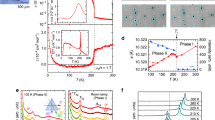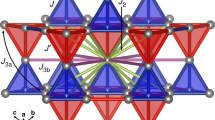Abstract
Inorganic compounds with the AB2X4 spinel structure have been studied for many years, because of their unusual physical properties. The spinel crystallographic structure, first solved by Bragg in 19151, has cations occupying both tetrahedral (A) and octahedral (B) sites. Interesting physics arises when the B-site cations become mixed in valence. Magnetite (Fe3O4) is a classic and still unresolved example, where the tendency to form ordered arrays of Fe2+ and Fe3+ ions competes with the topological frustration of the B-site network2. The CuIr2S4 thiospinel is another example, well known for the presence of a metal–insulator transition at 230 K with an abrupt decrease of the electrical conductivity on cooling accompanied by the loss of localized magnetic moments3,4,5,6,7. Here, we report the determination of the crystallographic structure of CuIr2S4 below the metal–insulator transition. Our results indicate that CuIr2S4 undergoes a simultaneous charge-ordering and spin-dimerization transition—a rare phenomenon in three-dimensional compounds. Remarkably, the charge-ordering pattern consists of isomorphic octamers of Ir83+S24 and Ir84+S24 (as isovalent bi-capped hexagonal rings). This extraordinary arrangement leads to an elegant description of the spinel structure, but represents an increase in complexity with respect to all the known charge-ordered structures, which are typically based on stripes, slabs or chequerboard patterns.
This is a preview of subscription content, access via your institution
Access options
Subscribe to this journal
Receive 51 print issues and online access
$199.00 per year
only $3.90 per issue
Buy this article
- Purchase on Springer Link
- Instant access to full article PDF
Prices may be subject to local taxes which are calculated during checkout



Similar content being viewed by others
References
Bragg, W. H. The structure of magnetite and the spinels. Nature 95, 561–561 (1915).
Iizumi, M. et al. Structure of magnetite (Fe3O4) below the Verwey transition temperature. Acta Crystallogr. 38, 2121–2133 (1982).
Furubayashi, T., Matsumoto, T., Hagino, T. & Nagata, S. Structural and magnetic studies of metal-insulator transition in thiospinel CuIr2S4. J. Phys. Soc. Jpn 63, 3333–3339 (1994).
Matsuno, J. et al. Photoemission study of the metal-insulator transition in CuIr2S4. Phys. Rev. B 55, R15979–R15982 (1997).
Nagata, S. et al. Metal-insulator transition in the spinel-type CuIr2(S1-xSex)4 system. Phys. Rev. B 58, 6844–6854 (1998).
Matsumoto, N., Endoh, R., Nagata, S., Furubayashi, T. & Matsumoto, T. Metal-insulator transition and superconductivity in the spinel-type Cu(Ir1-xRhx)2S4 system. Phys. Rev. B 60, 5258–5265 (1999).
Burkov, A. T. et al. Anomalous resistivity and thermopower of the spinel-type compounds CuIr2S4 and CuIr2Se4. Phys. Rev. B 61, 10049–10056 (2000).
Bray, J. W. et al. Observation of a spin-Peierls transition in a Heisenberg antiferromagnetic linear-chain system. Phys. Rev. Lett. 35, 744–747 (1975).
Jacobs, I. S. et al. Spin-Peierls transitions in magnetic donor-acceptor compounds of tetrathiafulvalene (TTF) with bisdithiolene metal complexes. Phys. Rev. B 14, 3036–3051 (1976).
Bray, J. W., Interrante, I. V., Jacobs, I. S. & Bonner, J. C. Extended Linear Chain Compounds (ed. Miller, J. S.) (Plenum, New York, 1983).
Ishibashi, H., Sakai, T. & Nakahigashi, K. X-ray diffraction study on spinel compound CuIr2S4 with metal-insulator transition. J. Magn. Magn. Mater. 226–230, 233–234 (2001).
Billinge, S. J. L. & Egami, T. Short-range atomic structure of Nd2-xCexCuO4-y determined by real-space refinement of neutron-powder-diffraction data. Phys. Rev. B 47, 14386–14406 (1993).
Kumagai, K., Kakuyanagi, K., Endoh, R. & Nagata, S. NMR study on the metal-insulator transition of (Cu1-xNix)Ir2S4. Physica C 341, 741–742 (2000).
Hase, M., Terasaki, I. & Uchinokura, K. Observation of the spin-Peierls transition in linear Cu2+ (spin-1/2) chains in an inorganic compound CuGeO3. Phys. Rev. Lett. 70, 3651–3654 (1993).
Hirota, K. et al. Dimerization of CuGeO3 in the Spin-Peierls state. Phys. Rev. Lett. 73, 736–739 (1994).
Lüdecke, J. et al. Acentric low-temperature superstructure of NaV2O5. Phys. Rev. Lett. 82, 3633–3636 (1999).
Marezio, M., McWhan, D. B., Derniew, P. D. & Remeika, J. P. Charge localization at metal-insulator transitions in Ti4O7. Phys. Rev. Lett. 28, 1390–1393 (1972).
Anderson, P. W. Ordering and antiferromagnetism in ferrites. Phys. Rev. 102, 1008–1013 (1956).
Rodríguez-Carvajal, J., Rousse, G., Masquelier, C. & Hervieu, M. Electronic crystallization in a lithium battery material: columnar ordering of electrons and holes in the spinel LiMn2O4. Phys. Rev. Lett. 81, 4660–4663 (1998).
Stokes, H. T. & Hatch, D. M. Isotropy Subgroups of the 230 Crystallographic Space Groups (World Scientific, Singapore, 1988).
Larson, A. C. & von Dreele, R. B. (The Regents of the University of California, Los Alamos, 1985).
Peterson, P. F., Gutmann, M., Proffen, T. & Billinge, S. J. L. PDFgetN: a user-friendly program to extract the total scattering structure factor and the pair distribution function from neutron powder diffraction data. J. Appl. Crystallogr. 33, 1192 (2000).
Proffen, T. & Billinge, S. J. L. PDFFIT, a program for full profile structural refinement of the atomic pair distribution function. J. Appl. Crystallogr. 32, 572–575 (1999).
Acknowledgements
Y.-S.H., V.K. and S-W.C. were partially supported by the National Science Foundation; Y.H. acknowledges the support of a JSPS Postdoctoral Fellowship for Research Abroad.
Author information
Authors and Affiliations
Corresponding author
Ethics declarations
Competing interests
The authors declare no competing financial interests.
Supplementary information
Rights and permissions
About this article
Cite this article
Radaelli, P., Horibe, Y., Gutmann, M. et al. Formation of isomorphic Ir3+ and Ir4+ octamers and spin dimerization in the spinel CuIr2S4. Nature 416, 155–158 (2002). https://doi.org/10.1038/416155a
Received:
Accepted:
Issue Date:
DOI: https://doi.org/10.1038/416155a
This article is cited by
-
Geometric frustration of Jahn–Teller order in the infinite-layer lattice
Nature (2023)
-
Coexisting Z-type charge and bond order in metallic NaRu2O4
Communications Materials (2022)
-
Slow dynamics of disordered zigzag chain molecules in layered LiVS2 under electron irradiation
npj Quantum Materials (2021)
-
Site-selective doping of ordered charge states in magnetite
Nature Communications (2020)
-
Regular-triangle trimer and charge order preserving the Anderson condition in the pyrochlore structure of CsW2O6
Nature Communications (2020)
Comments
By submitting a comment you agree to abide by our Terms and Community Guidelines. If you find something abusive or that does not comply with our terms or guidelines please flag it as inappropriate.



